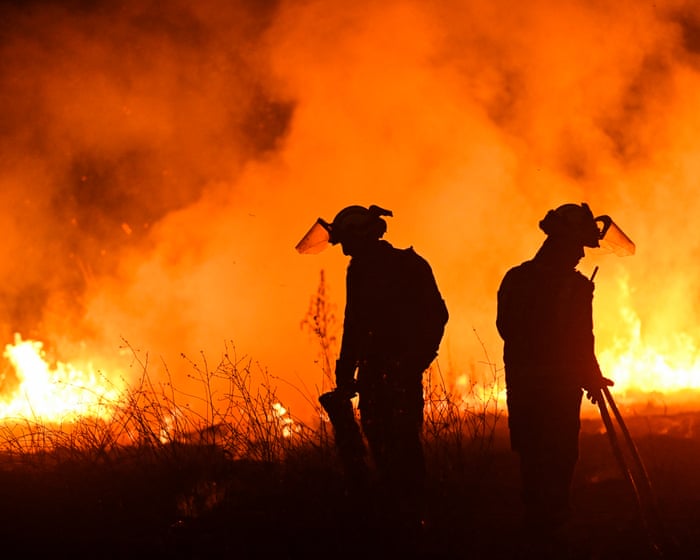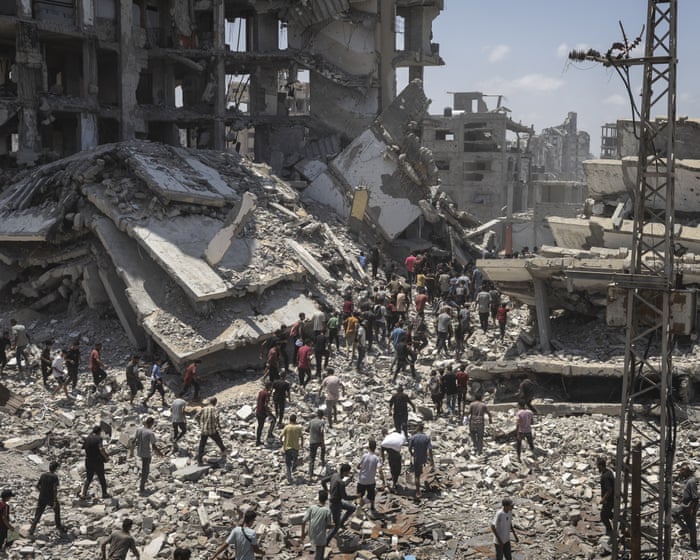Growing up in Madrid, I was used to scorching summers. I quickly learned to always walk on the shady side of the street and avoid being outside at the hottest time of day. As a child in the early 1980s, I never felt dizzy from the heat or struggled to study or sleep because of high temperatures. Back then, air conditioning was rare—something we associated with Americans. But we managed just fine—the rattling fan in my mother’s Ford Fiesta was enough to keep us comfortable during summer trips out of the city.
What’s happening in Spain now goes far beyond mere discomfort. This summer alone, over 1,500 deaths have been linked to heatwaves. Public workers collapse from heatstroke on city streets, and wildfires have devastated communities near Madrid. On Monday, 198 weather stations recorded temperatures above 40°C. After a record-breaking July, the first 20 days of August will likely be the hottest ever recorded. Alongside housing shortages, the climate crisis is Spain’s most urgent and persistent problem—every summer drives this home. It’s impossible to ignore or escape, so why are Spanish politicians still dragging their feet?
Fighting global heating is a global challenge, but protecting people from its effects—especially in Europe, which is warming faster than other continents—must be a national and local priority. Yet in Spain, the climate crisis often gets reduced to petty political squabbles. While most Spaniards agree on the need for action, politicians have turned it into a partisan battleground, with left and right fighting over symbolic policies about cars and bikes.
Even Spain’s center-left government, led by Pedro Sánchez’s Socialist Party (PSOE), has taken only modest steps to cut emissions from industry and transport. And like on other issues, the Socialists are quick to blame regional and local governments run by the conservative People’s Party (PP), sometimes backed by the far-right Vox party, which spreads climate denial and conspiracy theories.
It’s true that Spain’s powerful, well-funded regional governments also bear responsibility—for shielding vulnerable people from extreme heat, adapting public spaces, planting trees, and ensuring enough shade and water fountains. One urgent need is “cool banks”—refuges for those in overcrowded, overheated homes, the elderly, the very young, and people with health conditions. Valencia has a network of climate shelters, while Barcelona has mapped hundreds of cooling spaces, from libraries to museums.
But too many local governments are failing to provide relief. Madrid is among the worst. Public cooling centers barely exist, leaving shopping malls as the only escape. The capital’s conservative leaders have ignored or even resisted demands to reduce dangerous heat in neighborhoods with too few green spaces and too many cars. When Madrid does spend money, it’s often wasted—like the revamped Puerta del Sol, which still feels like a concrete frying pan in summer. Only after protests did the city install flimsy shades, costing €1.5 million.
For those who can afford it, fleeing Madrid for the coast has long been the August tradition. My childhood memories of cooler summers visiting grandparents in northern Spain feel like a distant dream. While the north still has bearable nights and occasional summer rain, heatwaves are becoming more frequent there too. The change is undeniable.Wildfires are fast-moving and highly visible, even in everyday life. But just how dangerous are they, and what can we do to prevent them from worsening?
This year in the Basque Country, beaches have repeatedly been closed due to the Portuguese man o’ war—a jellyfish-like creature that is far more toxic and dangerous. Once limited to warmer Atlantic waters, it has only recently started appearing here. During a walk along San Sebastián’s beach, I noticed dozens of them, thankfully small, each marked in the sand to warn passersby. Authorities are now dedicating more medical resources and surveillance to this new threat—just one example of the small but necessary adjustments we’re being forced to make.
The most severe impacts of the climate crisis dominate global headlines: tragic deaths of outdoor workers harvesting fruit or cleaning streets, wildfires claiming lives, destroying homes, and even damaging a Roman-era mining site—now a charred UNESCO World Heritage Site. But across Spain, the signs are everywhere—crops ruined by hail, high-speed trains delayed, and neighborhoods sweltering under extreme heat.
This is our new reality, now a fixed part of our lives. A journalist colleague remarked earlier this year that for the media, the most significant annual climate event isn’t COP—it’s summer. It was only February in the Northern Hemisphere, and he was already preparing coverage for the inevitable heatwaves. My newsroom in Madrid does the same, with increasingly detailed data and analysis.
The real frustration is why politicians continue to dismiss this reality as a mere inconvenience. How many shattered records and heat-related deaths will it take for them to act?
María Ramírez is a journalist and deputy managing editor of elDiario.es, a Spanish news outlet.
FAQS
### **FAQs About Spain’s Deadly Heatwaves and Political Inaction**
#### **Basic Questions**
**1. Why are heatwaves in Spain becoming more frequent and deadly?**
Climate change is increasing global temperatures, making heatwaves more intense, longer-lasting, and more frequent. Spain’s geography makes it particularly vulnerable.
**2. Are heatwaves really a yearly occurrence now?**
Yes. Recent years have seen record-breaking temperatures, with heatwaves occurring every summer, often earlier and more severe than before.
**3. What are the dangers of these heatwaves?**
Extreme heat causes dehydration, heatstroke, and even death, especially among the elderly and vulnerable. It also worsens droughts, wildfires, and crop failures.
**4. Why aren’t politicians doing more to address this?**
Some politicians downplay climate change due to economic interests, short-term political priorities, or ties to industries that resist environmental regulations.
—
#### **Intermediate Questions**
**5. What policies should Spain implement to combat heatwaves?**
Possible solutions include:
– Better urban planning.
– Stronger heatwave emergency plans.
– Faster transition to renewable energy.
– Stricter water conservation laws.
**6. Are other European countries handling heatwaves better?**
Some, like France and Germany, have implemented stricter heat action plans, including public cooling centers and better healthcare responses. Spain lags behind in preparedness.
**7. How does denying or ignoring heatwaves affect public health?**
Without proper warnings and infrastructure, more people suffer preventable heat-related illnesses and deaths, especially in poorer neighborhoods with less access to cooling.
**8. Is Spain investing enough in renewable energy to fight climate change?**
Spain is a leader in wind and solar power, but political delays and fossil fuel lobbying slow down faster progress.
—
#### **Advanced Questions**
**9. What economic interests conflict with heatwave action in Spain?**
Industries like mass tourism, construction, and agriculture resist policies that could reduce profits, even if they worsen climate risks.
**10. How does Spain’s political system contribute to inaction on climate change?**
Short election cycles make politicians focus on immediate issues rather than long-term climate policies. Also, regional vs. national disputes slow down unified action.




